�
�
519.7 dc21
97-6931
�
�
To Pierrette and Marie
�
Preface
According to a French saying “G´erer, c’est pr´evoir,” which we may trans-
late as “(The art of) Managing is (in) foreseeing.” Now, probability and
statistics have long since taught us that the future cannot be perfectly
forecast but instead should be considered random or uncertain. The aim of
stochastic programming is precisely to find an optimal decision in problems
involving uncertain data. In this terminology, stochastic is opposed to de-
terministic and means that some data are random, whereas programming
refers to the fact that various parts of the problem can be modeled as linear
or nonlinear mathematical programs. The field, also known as optimization
under uncertainty, is developing rapidly with contributions from many dis-
ciplines such as operations research, economics, mathematics, probability,
and statistics. The objective of this book is to provide a wide overview of
stochastic programming, without requiring more than a basic background
in these various disciplines.
Introduction to Stochastic Programming is intended as a first course for
beginning graduate students or advanced undergraduate students in such
fields as operations research, industrial engineering, business administra-
tion (in particular, finance or management science), and mathematics. Stu-
dents should have some basic knowledge of linear programming, elementary
analysis, and probability as given, for example, in an introductory book on
operations research or management science or in a combination of an in-
troduction to linear programming (optimization) and an introduction to
probability theory.
Instructors may need to add some material on convex analysis depending
on the choice of sections covered. We chose not to include such introductory
�
viii
Preface
material because students’ backgrounds may vary widely and other texts
include these concepts in detail. We did, however, include an introduction
to random variables while modeling stochastic programs in Section 2.1 and
short reviews of linear programming, duality, and nonlinear programming
at the end of Chapter 2. This material is given as an indication of the pre-
requisites in the book to help instructors provide any missing background.
In the Subject Index, the first reference to a concept is where it is defined
or, for concepts specific to a single section, where a source is provided.
In our view, the objective of a first course based on this book is to help
students build an intuition on how to model uncertainty into mathemati-
cal programs, which changes uncertainty brings into the decision process,
what difficulties uncertainty may bring, and what problems are solvable. To
begin this development, the first section in Chapter 1 provides a worked
example of modeling a stochastic program. It introduces the basic con-
cepts, without using any new or specific techniques. This first example can
be complemented by any one of the other proposed cases of Chapter 1,
in finance, in multistage capacity expansion, and in manufacturing. Based
again on examples, Chapter 2 describes how a stochastic model is formally
built. It also stresses the fact that several different models can be built,
depending on the type of uncertainty and the time when decisions must
be taken. This chapter links the various concepts to alternative fields of
planning under uncertainty.
Any course should begin with the study of those two chapters. The sequel
would then depend on the students’ interests and backgrounds. A typical
course would consist of elements of Chapter 3, Sections 4.1 to 4.5, Sections
5.1 to 5.3 and 5.7, and one or two more advanced sections of the instructor’s
choice. The final case study may serve as a conclusion. A class emphasizing
modeling might focus on basic approximations in Chapter 9 and sampling
in Chapter 10. A computational class would stress methods from Chapters
6 to 8. A more theoretical class might concentrate more deeply on Chapter
3 and the results from Chapters 9 to 11.
The book can also be used as an introduction for graduate students
interested in stochastic programming as a research area. They will find
a broad coverage of mathematical properties, models, and solution algo-
rithms. Broad coverage cannot mean an in-depth study of all existing re-
search. The reader will thus be referred to the original papers for details.
Advanced sections may require multivariate calculus, probability measure
theory, or an introduction to nonlinear or integer programming. Here again,
the stress is clearly in building knowledge and intuition in the field. Math-
ematical results are given so long as they are either basic properties or
helpful in developing efficient solution procedures. The importance of the
various sections clearly reflects our own interests, which focus on results
that may lead to practical applications of stochastic programming.
�

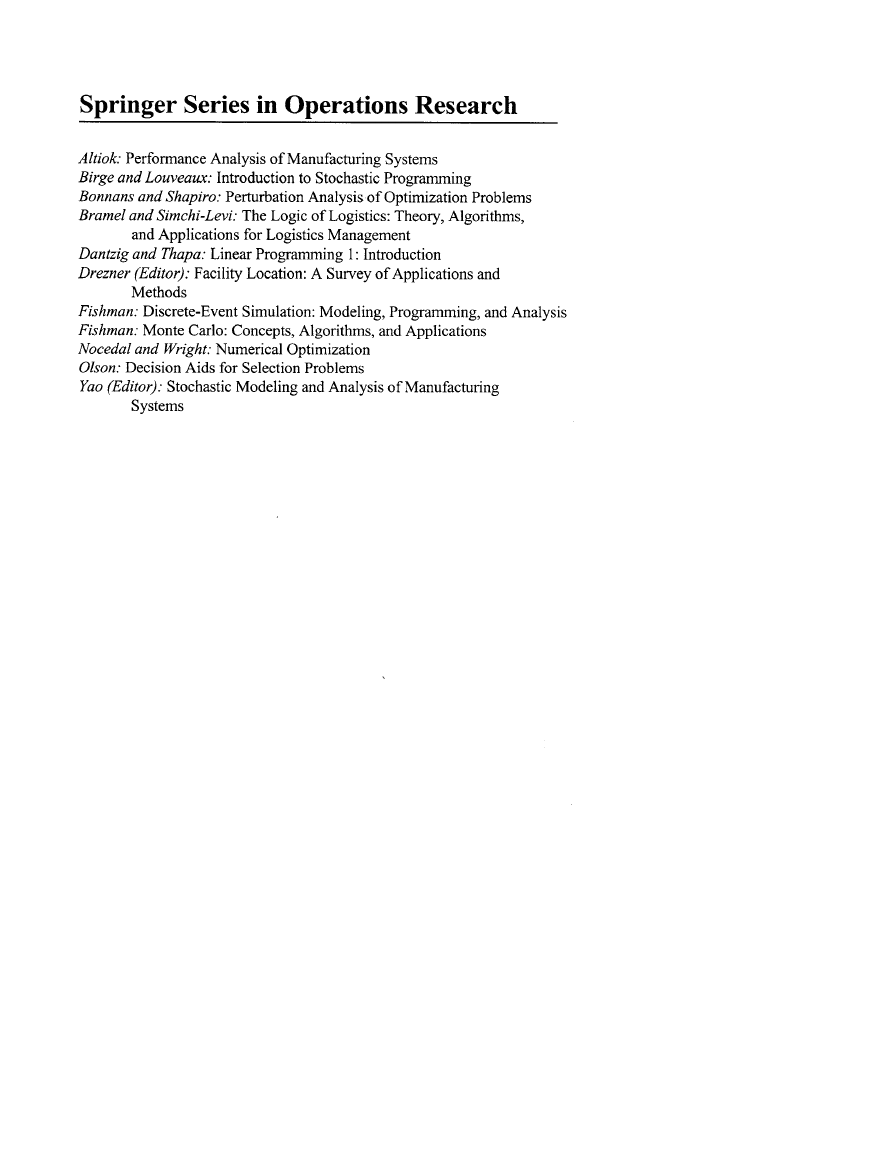
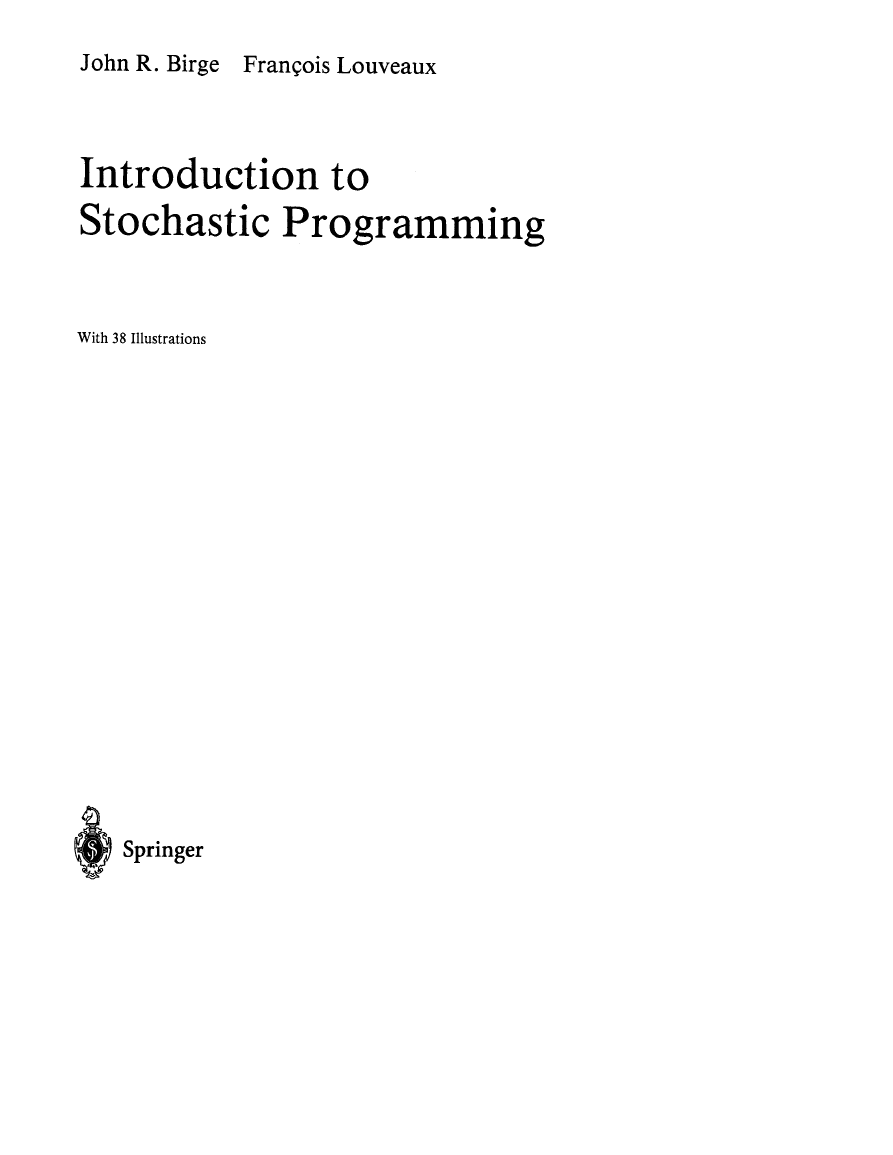
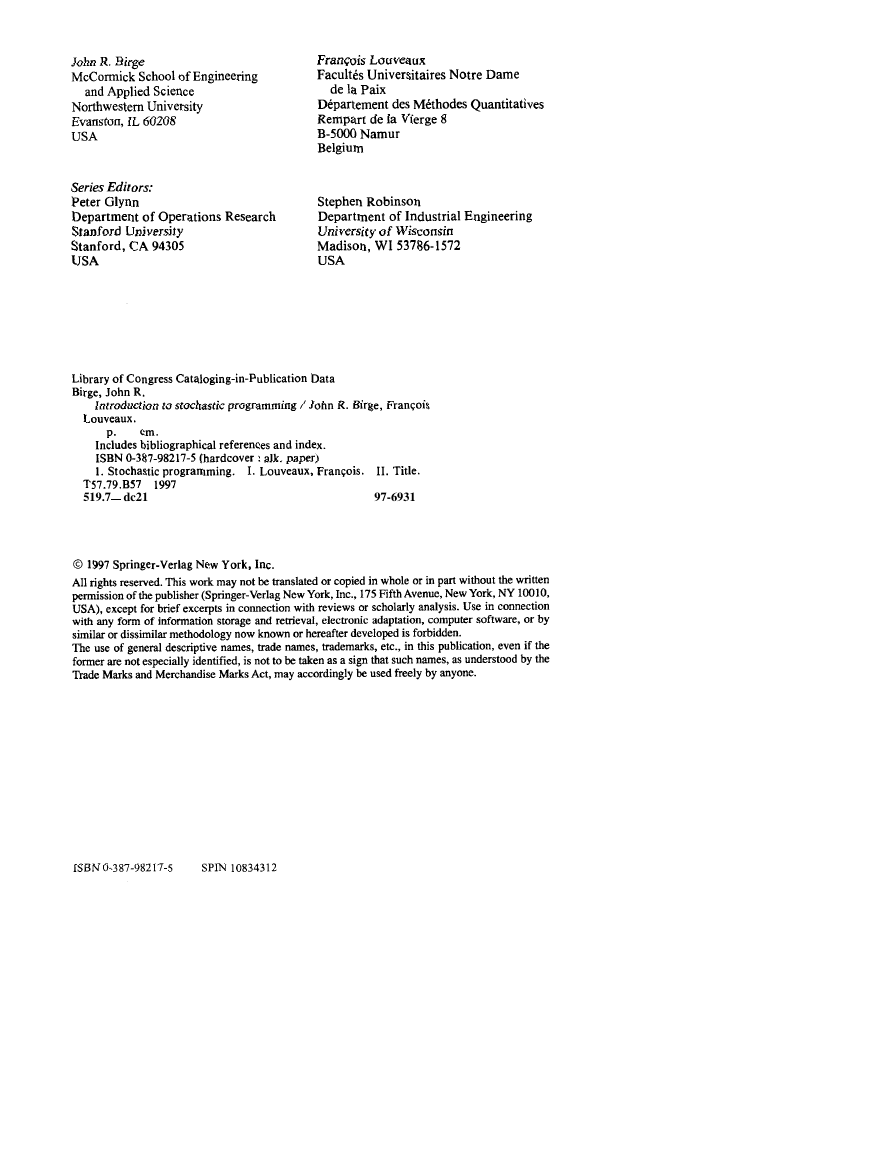


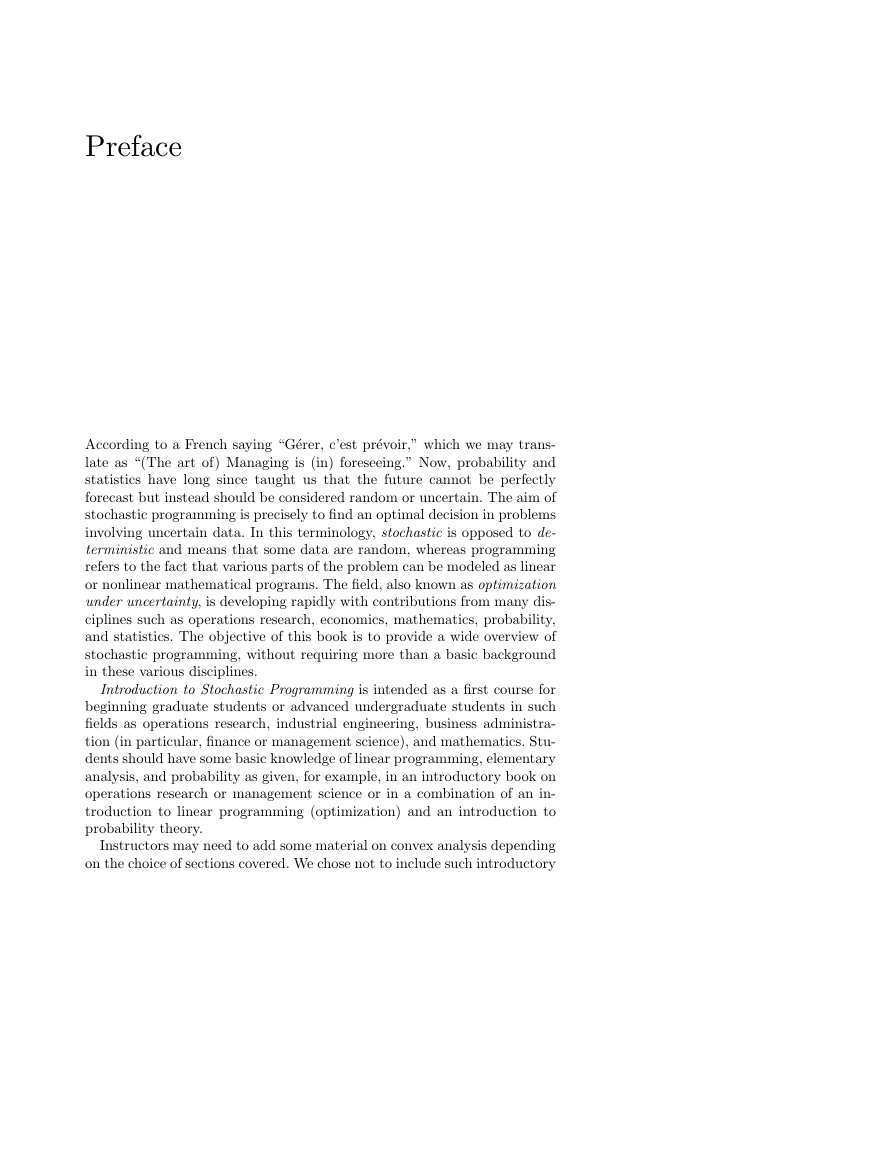
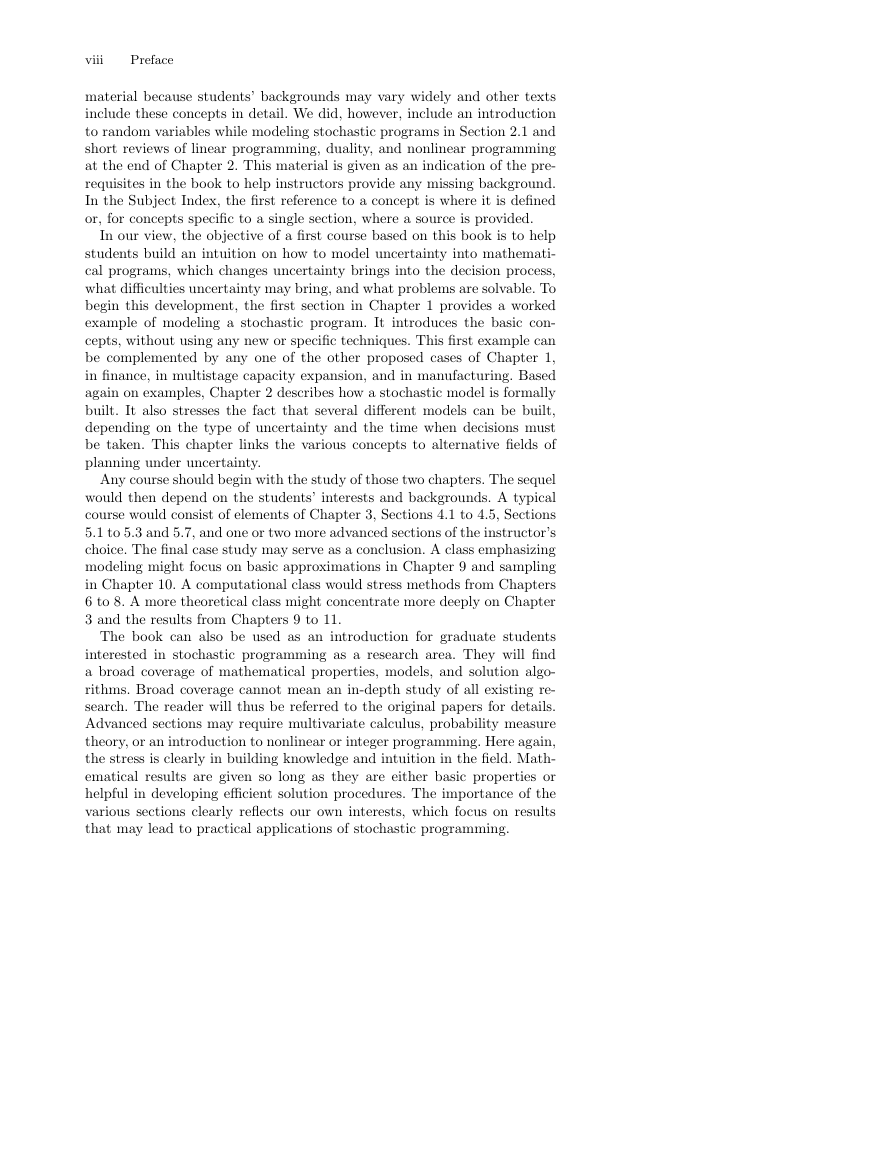








 2023年江西萍乡中考道德与法治真题及答案.doc
2023年江西萍乡中考道德与法治真题及答案.doc 2012年重庆南川中考生物真题及答案.doc
2012年重庆南川中考生物真题及答案.doc 2013年江西师范大学地理学综合及文艺理论基础考研真题.doc
2013年江西师范大学地理学综合及文艺理论基础考研真题.doc 2020年四川甘孜小升初语文真题及答案I卷.doc
2020年四川甘孜小升初语文真题及答案I卷.doc 2020年注册岩土工程师专业基础考试真题及答案.doc
2020年注册岩土工程师专业基础考试真题及答案.doc 2023-2024学年福建省厦门市九年级上学期数学月考试题及答案.doc
2023-2024学年福建省厦门市九年级上学期数学月考试题及答案.doc 2021-2022学年辽宁省沈阳市大东区九年级上学期语文期末试题及答案.doc
2021-2022学年辽宁省沈阳市大东区九年级上学期语文期末试题及答案.doc 2022-2023学年北京东城区初三第一学期物理期末试卷及答案.doc
2022-2023学年北京东城区初三第一学期物理期末试卷及答案.doc 2018上半年江西教师资格初中地理学科知识与教学能力真题及答案.doc
2018上半年江西教师资格初中地理学科知识与教学能力真题及答案.doc 2012年河北国家公务员申论考试真题及答案-省级.doc
2012年河北国家公务员申论考试真题及答案-省级.doc 2020-2021学年江苏省扬州市江都区邵樊片九年级上学期数学第一次质量检测试题及答案.doc
2020-2021学年江苏省扬州市江都区邵樊片九年级上学期数学第一次质量检测试题及答案.doc 2022下半年黑龙江教师资格证中学综合素质真题及答案.doc
2022下半年黑龙江教师资格证中学综合素质真题及答案.doc